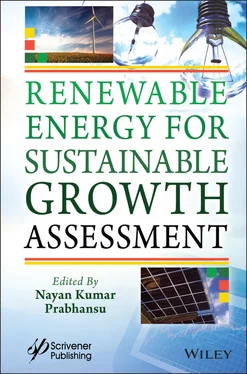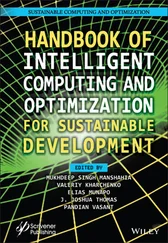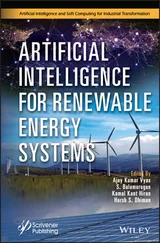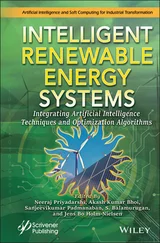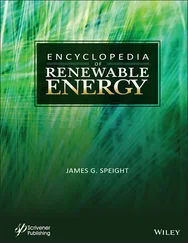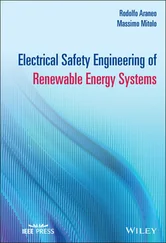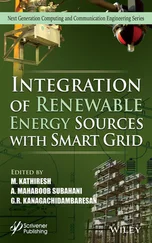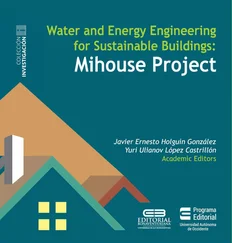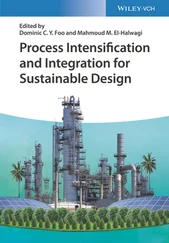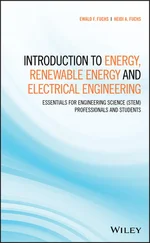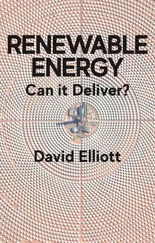Renewable Energy for Sustainable Growth Assessment
Здесь есть возможность читать онлайн «Renewable Energy for Sustainable Growth Assessment» — ознакомительный отрывок электронной книги совершенно бесплатно, а после прочтения отрывка купить полную версию. В некоторых случаях можно слушать аудио, скачать через торрент в формате fb2 и присутствует краткое содержание. Жанр: unrecognised, на английском языке. Описание произведения, (предисловие) а так же отзывы посетителей доступны на портале библиотеки ЛибКат.
- Название:Renewable Energy for Sustainable Growth Assessment
- Автор:
- Жанр:
- Год:неизвестен
- ISBN:нет данных
- Рейтинг книги:4 / 5. Голосов: 1
-
Избранное:Добавить в избранное
- Отзывы:
-
Ваша оценка:
- 80
- 1
- 2
- 3
- 4
- 5
Renewable Energy for Sustainable Growth Assessment: краткое содержание, описание и аннотация
Предлагаем к чтению аннотацию, описание, краткое содержание или предисловие (зависит от того, что написал сам автор книги «Renewable Energy for Sustainable Growth Assessment»). Если вы не нашли необходимую информацию о книге — напишите в комментариях, мы постараемся отыскать её.
This outstanding new volume
Renewable Energy for Sustainable Growth Assessment — читать онлайн ознакомительный отрывок
Ниже представлен текст книги, разбитый по страницам. Система сохранения места последней прочитанной страницы, позволяет с удобством читать онлайн бесплатно книгу «Renewable Energy for Sustainable Growth Assessment», без необходимости каждый раз заново искать на чём Вы остановились. Поставьте закладку, и сможете в любой момент перейти на страницу, на которой закончили чтение.
Интервал:
Закладка:
Table of Contents
1 Cover
2 Title Page
3 Copyright
4 Preface
5 1 Biomass as Emerging Renewable: Challenges and Opportunities 1.1 Introduction 1.2 Bioenergy Chemical Characterization 1.3 Technologies Available for Conversion of Bioenergy 1.4 Progress in Scientific Study 1.5 Status of Biomass Utilization in India 1.6 Major Issues in Biomass Energy Projects 1.7 Challenges in Commercialization 1.8 Concluding Remarks References
6 2 Assessment of Renewable Energy Technologies Based on Sustainability Indicators for Indian Scenario Nomenclature 2.1 Introduction 2.2 RE Scenario in India 2.3 Impact of COVID-19 on RE Sector in India 2.4 Sustainability Assessment of RE Technologies 2.5 Ranking of RE Technologies 2.6 Results and Discussion 2.7 Conclusion References
7 3 A Review of Biomass Impact and Energy Conversion 3.1 Introduction 3.2 Non-Renewable Energy Resources: Crisis and Demand 3.3 Environmental Impacts and Control by Biomass Conversion 3.4 Future Trends 3.5 Conclusion Acknowledgment References
8 4 Power Electronics for Renewable Energy Systems 4.1 Introduction: Need of Renewable Energy System 4.2 Power Electronics Technologies 4.3 Energy Conversion Controller Design Using Power Electronics 4.4 Carbon Emission Reduction Using Power Electronics 4.5 Efficient Transmission of Power 4.6 Issues and Challenges of Power Electronics 4.7 Energy Storage Utilized by Power Electronics for Power System 4.8 Application of Power Electronics 4.9 Case Study on PV Farm and Wind Farm Using Converter Modelling 4.10 Reliability of Renewable Energy System 4.11 Conclusion References
9 5 Thermal Performance Studies of an Artificially Roughened Corrugated Aluminium Alloy (AlMn1Cu) Plate Solar Air Heater (SAH) at a Moderate Air Flow Rate Nomenclature 5.1 Introduction 5.2 Methodology 5.3 Results and Discussion 5.4 Conclusions Acknowledgement References
10 6 An Overview of Partial Shading on PV Systems Nomenclature 6.1 Introduction 6.2 Basics of Partial Shading 6.3 Mitigation of Partial Shading Using Array Reconfiguration Techniques 6.4 Case Study on Different Techniques of Array Reconfiguration According to its Classification – (2015-2020)6.5 Future Directions 6.6 Discussion & Conclusion References
11 7 Optical Modeling Techniques for Bifacial PV Nomenclature 7.1 Introduction 7.2 Background 7.3 Bifacial PV System and Modelling 7.4 Effect of Installation and Weather Parameters on Energy Yield 7.5 Conclusion References
12 8 Intervention of Microorganisms for the Pretreatment of Lignocellulosic Biomass to Extract the Fermentable Sugars for Biofuel Production 8.1 Introduction 8.2 Lignocellulosic Biomass 8.3 Role of Pretreatment in Biofuel Generations 8.4 Biological Pretreatment and its Significance 8.5 Combined Biological Pretreatment Case Studies and Opportunities 8.6 Future Prospects 8.7 Conclusion Acknowledgement Conflicts of Interest References
13 9 Biomass and Bioenergy: Resources, Conversion and Application 9.1 Introduction to Biomass 9.2 Classification of Biomass Resources 9.3 Biomass to Bioenergy Conversion 9.4 Environmental Impacts of Biomass & Bioenergy 9.5 Solutions to the Environmental Impacts 9.6 Case Study of US – Conversion of MSW to Energy 9.7 Bioenergy Products 9.8 Effects of Covid-19 on Bioenergy Sector References
14 10 Renewable Energy Development in Africa: Lessons and Policy Recommendations from South Africa, Egypt, and Nigeria 10.1 Introduction 10.2 Existing Knowledge and Contributions to Literature 10.3 Renewable Energy Development in South Africa 10.4 Renewable Energy Development in Egypt 10.5 Renewable Energy Development in Nigeria 10.6 Conclusion and Policy Implications 10.7 Conclusion References
15 11 Sustainable Development of Pine Biocarbon Derived Thermally Stable and Electrically Conducting Polymer Nanocomposite Films 11.1 Introduction 11.2 Experimental Procedures 11.3 Characterization 11.4 Results and Discussion 11.5 Electrical Behaviour of ECF 11.6 Conclusion and Future Aspects Acknowledgement References
16 12 Power Electronics for Renewable Energy Systems 12.1 Introduction 12.2 Power Electronics on Energy Systems and its Impact 12.3 The Power Electronics Contribution and its Challenges in the Current Energy Scenario 12.4 Recent Growth in Power Semiconductor Technology 12.5 A New Class of Power Converters for Renewable Energy Systems: AC-Link Universal Power Converters 12.6 Power Converters for Wind Turbines and Power Semiconductors for Wind Power Converter 12.7 Recent Developments in Multilevel Inverter Based PV Systems 12.8 AC-DC-AC Converters for Distributed Power Generation Systems 12.9 Multilevel Converter/Inverter Topologies and Applications 12.10 Multiphase Matrix Converter Topologies 12.11 Boost Pre-Regulators for Power Factor Correction in Single-Phase Rectifiers 12.12 Active Power Filter 12.13 Common-Mode Voltage and Bearing Currents in PWM Inverters: Causes, Effects and Prevention 12.14 Single-Phase Grid-Side Converters 12.15 Impedance Source Inverters 12.16 Conclusion References
17 13 Fuel Cells for Alternative and Sustainable Energy Systems 13.1 Introduction to Fuel Cell Systems 13.2 Overview of Fuel Technology 13.3 Energy Storage Applications of Fuel Cells 13.4 Environmental Impact of Fuel Cell System 13.5 Latest Developments in Fuel Cell Technology 13.6 Future Perspective of Fuel Cell 13.7 Case Studies 13.8 Summary References
18 14 Fuel Cell Utilization for Energy Storage 14.1 Introduction to Fuel Cells 14.2 Fuel Cell Mechanism 14.3 Efficiency of Fuel Cell 14.4 Types of Fuel Cells 14.5 Hydrogen Production 14.6 Fuel Cells Applications and Advancements 14.7 Conclusions References
19 15 Miniature Hydel Energy Harvesting Unit to Power Auto Faucet and Lighting Systems for Domestic Applications 15.1 Introduction 15.2 Literature Review 15.3 Data Collection and Theoretical Hydraulic Power Calculations 15.4 Architecture and Working of Prototypes 15.5 Design and Simulation 15.6 Fabrication of Prototypes 15.7 Experimentation of Prototypes 15.8 Experimentation for Auto Faucet System 15.9 Conclusions References
20 16 Modeling, Performance Analysis, Impact Study and Operational Paradigms of Solar Photovoltaic Power Plant 16.1 Introduction 16.2 Solar Energy 16.3 Modeling of PV Modules 16.4 Design of 12 MWp SPP 16.5 Field Equipment Details 16.6 Performance Analysis 16.7 Technical Issues and New Paradigms 16.8 Opportunities and Future Scope 16.9 Conclusions References
21 17 A Review on Control Technologies and Islanding Issues in Microgrids 17.1 Introduction 17.2 Importance of Microgrid 17.3 Microgrid Types 17.4 Problems in Islanded Mode of Operation 17.5 Features of Microgrid Control System 17.6 Microgrid Islanding 17.7 Control Techniques 17.8 Autonomous Control Architecture 17.9 Optimization of Control in Microgrids 17.10 Inverter Control in Microgrids 17.11 Droop Control 17.12 Modern Prospects of Microgrid Research 17.13 Conclusion References
22 18 A Review of Microgrid Protection Schemes Resilient to Weather Intermittency and DER Faults 18.1 Introduction 18.2 Islanding Detection 18.3 Protection Challenges Due to Weather Intermittency 18.4 Protection Challenges Due to Converter Faults 18.5 Protection Challenges Due to PV Array Faults 18.6 Conclusion References
23 19 Theories of Finance for Generation Portfolio Optimization Acronyms 19.1 Introduction 19.2 Introduction to Portfolio Optimization 19.3 Using Fuzzy Logic to Create Risk and Reward Index 19.4 Markovitz Mean-Variance Theory 19.5 Black-Litterman Model 19.6 Mean Absolute Deviation (MAD) 19.7 Conditional Value at Risk (CVaR) 19.8 Results and Discussion 19.9 Conclusion References
24 20 Variable Speed Permanent Magnet Synchronous Generator-Wind Energy Systems 20.1 PMSG-Based WECS 20.2 System Modelling 20.3 Rotor Speed and Position Estimation Based on Stator SRF-PLL 20.4 Active Power and Current Reference Generation Scheme 20.5 Torsional Oscillation Damping 20.6 Conclusions Appendices and Nomenclature References
Читать дальшеИнтервал:
Закладка:
Похожие книги на «Renewable Energy for Sustainable Growth Assessment»
Представляем Вашему вниманию похожие книги на «Renewable Energy for Sustainable Growth Assessment» списком для выбора. Мы отобрали схожую по названию и смыслу литературу в надежде предоставить читателям больше вариантов отыскать новые, интересные, ещё непрочитанные произведения.
Обсуждение, отзывы о книге «Renewable Energy for Sustainable Growth Assessment» и просто собственные мнения читателей. Оставьте ваши комментарии, напишите, что Вы думаете о произведении, его смысле или главных героях. Укажите что конкретно понравилось, а что нет, и почему Вы так считаете.
